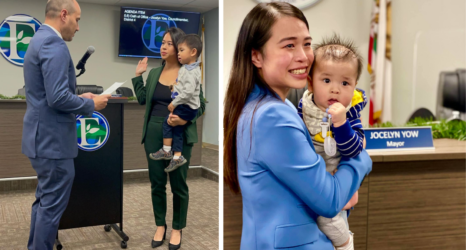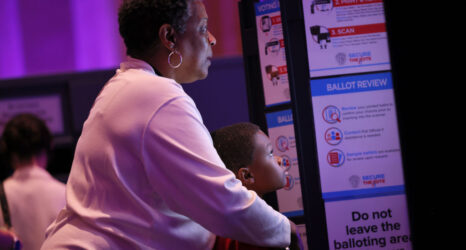With the 2018 election now in full swing, the Ms. Blog is excited to bring you content presented in conjunction with Gender Watch 2018, a project of the Barbara Lee Family Foundation and the Center for American Women and Politics. They’ll be tracking, analyzing and illuminating gender dynamics during election season—so check back with us regularly!
Record numbers of women are running for political office this year and everyone wants to know: are they running as women or like men? This question poses an inadequate binary—and assumes there exist monolithic models for touting womanhood or manhood in candidate presentation. Research on candidate strategy finds that the gendered style and substance of candidate presentation is much more complex, and that the effectiveness of strategies adapting to stereotypical notions of masculinity and femininity is context-dependent.
As we evaluate the ways in which candidates grapple with gender in presenting themselves to voters in 2018, it is worth considering the diversity of approaches by women and men, and the ways in which those approaches expand or enforce notions of masculinity and femininity—and what are deemed appropriate credentials for officeholding.
Women candidates have made headlines for making appeals rooted in their distinct experiences as women—whether as mothers of infants, trailblazing fighter pilots or survivors of sexual abuse. They have touted gender, or more specifically, gender-based experiences and perspectives, among their many credentials for office and called out the dominance of men in political institutions.
Just this week, New York U.S. House candidate Alexandria Ocasio-Cortez (D) released a web video that began: “Women like me aren’t supposed to run for office.” But they are—and in doing so, they are disrupting the status quo in U.S. campaigns that has favored masculinity, whiteness and heteronormativity for far too long. Even some Republican women, who have been historically less likely to tout gender difference, are discussing the benefits of women’s political inclusion on the campaign trail.
But evaluating the diversity of candidates’ presentation strategies also means taking note of women who have offered more traditional images of candidacy or gender. In Alabama’s race for governor, for example, a pre-primary ad for incumbent Governor Kay Ivey (R) adhered to strict models of both conservativism and masculinity. In the ad narrated by two white men at a shooting range, Ivey is touted as “tough as nails” and a “straight shooter,” and is later shown shooting a gun.
The symbolism of guns is both ideological and gendered, often used to convey conservative bona fides as well as toughness via a tool of brute force. Guns are central in advertisements from Georgia Republican gubernatorial candidate Brian Kemp, as are strategic choices that reinforce traditional notions of masculinity as the credential by which candidacy should be won. In addition to featuring guns and explosions as overt symbols of power, one of Kemp’s advertisements seeks to appeal to voters in its portrayal of patriarchal masculinity. While Kemp sits in full manspread posture polishing his rifle, he intimidates his daughter’s potential suitor into laying out his platform for the governorship. In this ad, Kemp is the masculine protector who uses fear as tool by which to gain and wield power.
Kemp’s advertisements are an important reminder that while so much attention is paid to how women navigate their gender on the campaign trail, men play the gender card, too. Like women, they make strategic choices that are equally capable of maintaining or disrupting the status quo in campaigns that has favored masculinity and men.
Other male candidates are less overt than Kemp in their performance of masculinity. Erin Cassese has written about Democratic Senator Joe Manchin’s targeted appeals to men in his re-election advertisements, noting the literal absence of women. A recent re-election ad from Democratic Senator Jon Tester (MT) is similarly male-centric, despite its broad focus on treating veterans with respect. Whether intentional or not, these advertisements reinforce notions that West Virginia’s miners and Montana’s veterans are all men. Moreover, they seem to reassure potentially centrist male voters in conservative-leaning states that they are not being forgotten amidst the national attention to women’s uprising and influence.
This year’s male candidates are also running in an environment in which issues of sexual harassment and assault are particularly salient. How do they confront the negative associations of men and masculinity with these crimes? Damon Martinez, a Democratic candidate for New Mexico’s first congressional district, has touted his work to fight for sexual assault survivors as a federal prosecutor. In his ad, the female lists his achievements and calls Martinez “a good man,” creating a clear distinction between good and bad men in this #MeToo moment.
In his bid for Baltimore County Executive, Jim Brochin adopts a similar approach. Narrated by a young woman, a recent ad from Brochin praises his work to make it easier to convict serial sex offenders and assures viewers—women, specifically—that he is a candidate, and a man, “we can trust.”
New research from the Barbara Lee Family Foundation suggests that messages the address the problem of sexual harassment are effective for men and women candidates this year, but the academic research gauging effectiveness of candidates’ gender strategies provides few clear conclusions or simple models for success. In a recently published study, Erin Cassese and Mirya Holman find that “neither men nor women [candidates] can rely solely on the strengths stereotypically associated with their gender” to win. Mary Christine Banwart and Mitchell McKinney’s concept of a “gendered adaptiveness strategy” is also instructive, suggesting that candidates are more likely to adapt their gender performance to the distinct conditions under which their campaigns are run.
More than two decades ago, in their aptly titled volume Running as a Woman, Linda Witt, Karen Paget and Glenna Matthews wrote that “the work of reshaping American political institutions so that women can enter them on their own terms, exercise power comfortably, and design policies that include their needs and concerns” was still under construction. Paying close attention to the terms on which women and men are seeking entry into, and finding success in, our political institutions in 2018 will better reveal the degree to which that work is done.





